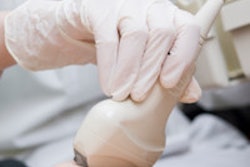
NEW YORK CITY - Is giving birth safely largely a privilege of the rich? It could be, given the shockingly high maternal death rates that still plague the developing world. But ultrasound can help, according to a March 18 talk at the American Institute of Ultrasound in Medicine (AIUM) annual meeting.
If widely adopted, prenatal ultrasound could significantly affect half of maternal deaths, including those due to hemorrhage, hypertension, and abortion, Dr. Alfred Abuhamad from Eastern Virginia Medical School told attendees.
What's more, ultrasound could impact the causes of nearly 70% of neonatal deaths in the developing world, such as preterm birth complications, intrapartum-related complications, and congenital abnormalities, he said.
Abuhamad spoke about the challenges facing global maternal health and how ultrasound can help during the plenary session of AIUM 2016 on Friday morning.
Maternal death
In the developing world, maternal death often results from three main issues: delays in deciding to seek care, delays in reaching the place of care, and delays in receiving appropriate treatment at the place of care, Abuhamad said.
In the U.S., the maternal mortality rate has dropped significantly over the past 100 years, but there are still some substantial variations among the states. In addition, there has been a troubling upward trend in maternal mortality over the past 10 to 15 years.
"If you look at the ratio of disparity within the U.S., there's about a threefold increase in maternal morbidity and mortality in the African-American community as compared with Hispanics and the white community," he said.
Globally, hemorrhage is the most frequent cause of maternal death, making up 27% of all deaths.
Much progress has been made over the past 25 years, however. Since 1990, the maternal mortality rate has been cut nearly in half, with much of the reduction taking place after 2000.
In addition, more than 71% of births were assisted by skilled health personnel worldwide in 2014, up 59% from 1990.
That said, there were still an estimated 289,000 maternal deaths worldwide in 2013.
"After years of slow progress, only half of pregnant women receive the recommended amount of prenatal care visits, which is four," Abuhamad said.
He noted that just 2,300 of the maternal deaths occurred in developed regions, with the remaining 286,700 in developing regions. As an example of the different dangers faced by pregnant women around the world, the lifetime risk of maternal mortality is 1 in 47,800 in Ireland, but 1 in 8 in Sierra Leone.
"It's very clear that giving birth safely is largely a privilege of the rich," Abuhamad said.
More than 80% of global maternal deaths could be prevented through timely interventions that have been proved over and over again to be effective and affordable.
"The issue has been access, availability, and -- really -- political will to make this happen," he said.
Maternal morbidity is also a massive problem. More than 300 million women in the developing world have short- or long-term illnesses related to pregnancy and childbirth. Fistula development is a notable issue, with up to 100,000 new annual cases estimated for Africa alone.
"Most are due to obstructed labor and [most] women with fistulas are pushed out of society due to personal hygiene," he said. "It is estimated that about 90% of fistula patients have contemplated suicide."
Even in the U.S., maternal morbidity has been on the rise. That's a very serious issue that needs to be addressed, Abuhamad said.
Child death
Childhood mortality and morbidity is also a serious global issue. Worldwide, 42% of children who die under the age of 5 are neonates. Of neonatal deaths, preterm birth complications (35%), intrapartum-related complications (24%), and sepsis (15%) are estimated to be the three leading causes of death.
Much progress has been made in lowering antenatal death rates, however. From the 1990s to 2013, mortality rates have dropped by about 50% for children younger than 5, 46% for infants, and 40% for neonates, Abuhamad said.
Yet problems remain, particularly in certain countries. In 2013, 45% of all deaths in children younger than 5 were in India, Nigeria, Pakistan, and the Democratic Republic of the Congo.
However, advances in maternal and child health, such as vaccines, aseptic techniques, clean water/rehydration, antibiotics, contraception, and access to care, have played major roles in lowering mortality rates around the world.
"If you look at the story of contraception alone, countries that have adopted rigorous contraception methods and made them available have consistently reduced maternal mortality by about two-thirds," Abuhamad said.
Ultrasound's potential effects
In the developing world, antenatal care is the most utilized of the maternal services and should be used as a platform to promote health and ensure safe delivery, according to Abuhamad.
"Ultrasound services, if introduced at that time, may play a critical role in this regard," he said.
Ultrasound significantly affects the prenatal diagnosis of women at risk for postpartum hemorrhage, including placental abnormalities.
"It also has a role in managing complicated pregnancies and the postpartum period, especially with retained product and certainly in ectopic pregnancies," he said.
The modality also has a role in labor, such as prenatal diagnosis of multiple pregnancies and abnormal fetal presentation, estimation of fetal weight, and management of obstructed labor. Perinatal asphyxia is another important application for ultrasound, aiding in accurate pregnancy dating, diagnosis of growth restriction, and assessment of fetal well-being and amniotic fluid volume, Abuhamad said.
"The concept is [if you could] identify at-risk pregnancies by introducing ultrasound in prenatal care, and then directing those at-risk pregnancies to deliver in a hospital setting and using ultrasound to manage complications as they arrive," he said.
Ultrasound has the potential to significantly affect 49% of maternal deaths, including those due to hemorrhage (27%), hypertension (14%), and abortion (8%). For neonates, the impact could be even greater. Ultrasound could affect the estimated cause of death in 69% of neonatal fatalities, including preterm birth complications (35%), intrapartum-related complications (24%), and congenital abnormalities (10%).
Current efforts
A number of initiatives have sought to expand the use of ultrasound in developing countries, including trips by the International Society of Ultrasound in Obstetrics and Gynecology (ISUOG) Outreach Program to Haiti (2009 and 2010) and Somaliland (2011 and 2012) in association with local nongovernmental organizations (NGOs) and governmental agencies, Abuhamad said.
From that work, a standard approach was developed to enable local users to perform a basic, six-step obstetric ultrasound examination in the second and third trimesters of pregnancy, he said.
In other success stories, ISUOG partner Sana Medical NGO has been active in supporting ultrasound imaging in Lebanon since May 2011. Abuhamad also acknowledged initiatives such as AIUM's Ultrasound in Global Health program, the World Federation for Ultrasound in Medicine and Biology's Centers of Excellence and educational efforts around the globe, the SonoWorld website, and the Imaging the World program.
"These [efforts] have tried to make a significant impact on introducing ultrasound and training to the healthcare team in the ability of diagnosing and identifying these high-risk pregnancies," he said.
Has the adoption of ultrasound worked in these environments? One study performed in 2008 found that the introduction of ultrasound services in a limited resource setting in rural Rwanda changed management in 103 (43%) of 242 patients and improved clinical outcomes.
"We are still awaiting a large [U.S. National Institutes of Health] trial that is evaluating in a cluster design the role of ultrasound in several communities around the world," he said. "I think this will show a good light for us about the value of introducing this technology to impact maternal mortality."
Challenges
Several challenges do remain, however. Many communities around the world face instability, and there is a need for volunteers to commit to spending time to train local health workers. It's also been more difficult and complicated lately to secure equipment donations from industry, he said.
In addition, there needs to be more evidence of ultrasound's efficacy before it can really be engaged in a larger setting, Abuhamad said.
In good news, many world organizations -- including the World Health Organization, the Bill and Melinda Gates Foundation, Merck for Mothers, and the United Nations -- are currently emphasizing the need to reduce maternal mortality.
On a societal level, an improvement in the status of women is also likely to lead to lower maternal mortality, according to Abuhamad.
"It has been shown over and over again, when women attain political clout in their communities and their cities and towns, maternal mortality significantly declines shortly thereafter," he said. "[This includes] providing education, providing contraception, providing access to care for women, and then documenting and reviewing events that lead to maternal mortality, where accountability is there and then changes are made to minimize the chances of these events occurring again."
On a healthcare level, a cultural change also needs to take place in these low-resource settings with regard to maternal mortality, including improvements in training and advocacy.
"What I have seen in the developing world is that many times women's lives are not valued, and not a lot of resources are placed to save them when really major events occur," he said.
Gender equality is probably the most important factor that would affect maternal mortality in the developing world.
Abuhamad closed with a topical quote from Dr. Mahmoud Fathalla, chair of the World Health Organization Advisory Committee on Health Research.
"Women are not dying of disease we cannot treat ... they are dying because societies have yet to make the decision that their lives are worth saving," Fathalla said.



















